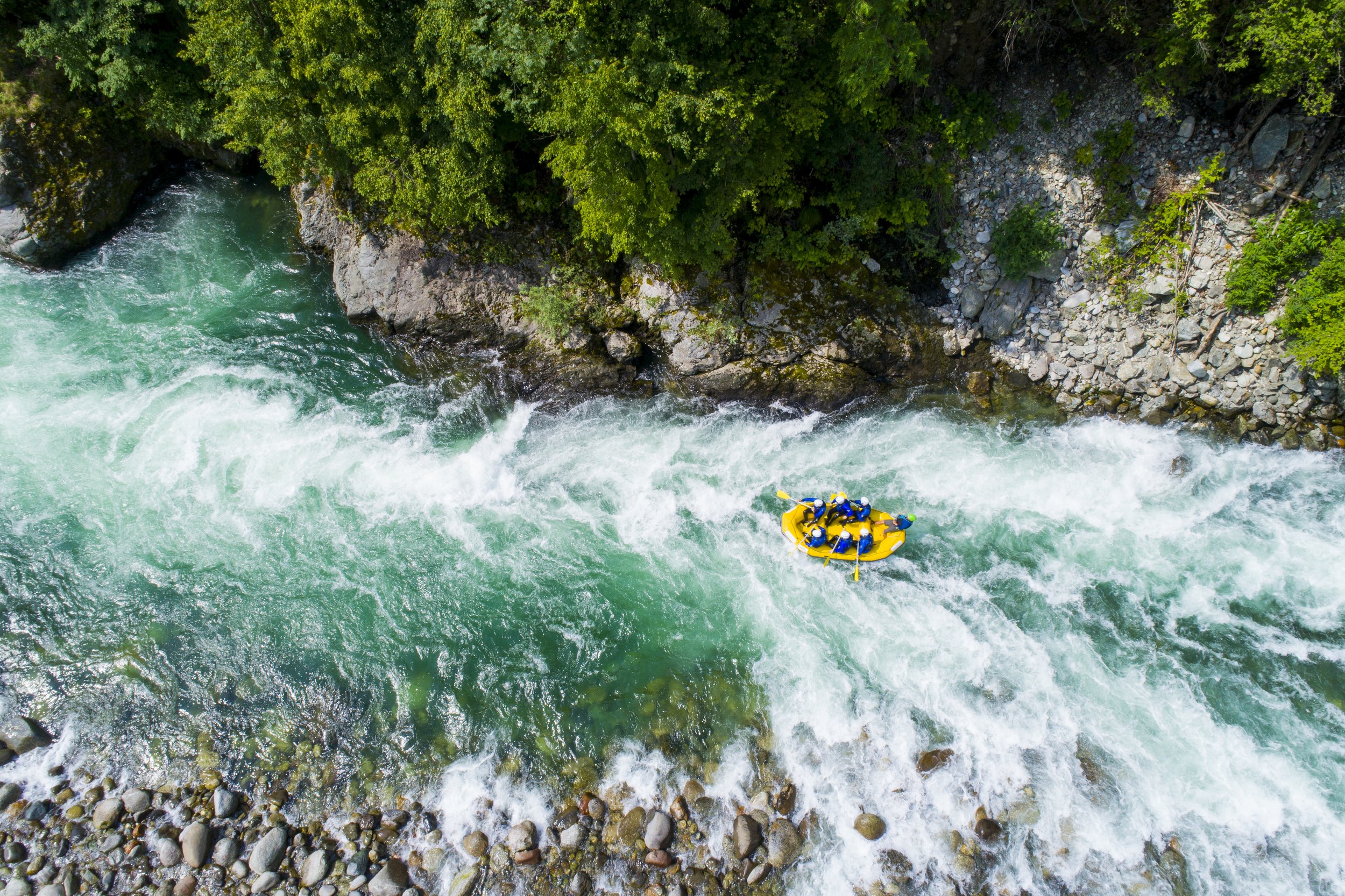Why Every River Guide Needs Swiftwater Rescue
EVERY GUIDE SHOULD TAKE A SWIFTWATER COURSE
If a river guide was to imagine their perfect day on the water, it would likely include a cloudless sky, a balmy tailwind, an enthusiastic group and exciting conditions on the river. All involved would end their day extremely satisfied having experienced the ultimate river trip. Rafting is meant to be challenging, exhilarating, and immensely rewarding, especially on such a day when your time on the water is uncomplicated. But, as any guide or outdoor enthusiast can attest, the realities of the river tend to be much more complex than simply having a good day or a bad day, and can wholly depend on how prepared the guide is to adapt to the circumstances that unfold.
A significant factor of becoming a successful guide is self-assurance - in conversations with guests, in the credibility of information shared, and in the ability to navigate the river. A Swiftwater Rescue course is the surest way to gain confidence in understanding the river technically. Because of all that guides stand to gain from such a course, there is certainly a significant amount of work to be expected from the two or three days spent paddling boats, throwing ropes, swimming across currents, and performing mid-river rescues. Depending on the time of year, participants could be carrying out such tasks in the freezing rain or snow of spring, or in the blistering heat of a late summer course. Environment and weather play a huge role in most emergency situations on the river, so being prepared for coursework in a variety of conditions is a relevant first lesson of a swiftwater or river rescue course.
Every day on the river is a good day, but rafting is not without risk. Swiftwater rescue teaches you to anticipate, prepare, prevent and react.
WHAT TO EXPECT
Before the course even begins, participants will likely be contacted by their instructors with information on what to bring, what to expect, and some pre-course reading material. As the course continues, expect the work to continue at home with scenarios to research and knots to practice. This should not be thought of as homework - expect to be taught by instructors who are experts in their fields and be sure to appreciate the wisdom they are willing to share. Participants should be ready to receive a flood of information and to be mentally exhausted by the end of the course! This is a particularly relevant lesson in swiftwater instruction that is taught intentionally - some of the worst situations on the river will be difficult to cope with as a guide or first responder, and mental exhaustion goes hand in hand with an intense rescue. It’s a great idea to write down a page or two of notes at the end of each day to help digest and remember such information.
Swiftwater courses usually involve around a dozen participants from different guiding backgrounds alongside recreational rafters looking to be well-educated for personal trips. Because of this, many of the scenarios involve multiple people in varying states of distress, such as a mid-river foot entrapment combined with a flipped raft and several swimmers, leading to a boat pin that involves ropes and pulleys. These situations can take hours to deal with, and even longer when participants must learn the intricacies of ropes systems and take turns rescuing others. Expect to be in and around the water for hours at a time and in a constant state of dampness, which could get uncomfortable if not otherwise prepared. There will certainly be excitement throughout the course as participants will get the chance to swim whitewater, attempt to scramble over strainers, and haul others back to shore while on live bait.
A river rescue student prepares to jump into a rapid on the Snake River in Jackson, WY.
Boaters of all experience levels will partake in Swiftwater Rescue courses, but the experience is fundamental for new guides. What the course doesn’t cover are the nuances of guiding - creating meaningful connections with guests on the boat and instilling in them an appreciation for their surroundings. First year guides will undoubtedly make mistakes in the beginning, such as flipping boats, missing a rapid, floating down the wrong channel, or getting a boat pinned. Whatever the situation, the passengers will be paying attention to how the guide reacts and what their response entails. A swiftwater-trained guide will have the tools for appropriate action with a cool head and an organized thought process. New guides are rarely alone on the river, and can therefore trust in the assistance of fellow guides who have had similar training, are eager to help, and have likely made the same mistakes before. Their feedback will be essential in alleviating mistakes and making certain the situation will not be repeated. Guides love to talk about their wildest rescues and their most terrific mishaps, anecdotes that are sure to be entertaining as well as informational!
THE BEST ADVICE FOR FIRST TIME GUIDES
One of the most efficient ways to combat mistakes is to practice and gain experience, and this means taking any and all trips that are offered. New guides often have to work their way up the ladder within their guiding community, meaning that any work is beneficial. The first several rafting trips a guide embarks upon with paying passengers will be full of anticipation. It is important to remember that the guests are also embarking on a completely foreign adventure, and they are placing their trust in their guide’s hands. The title of river guide is inherently impressive, and guests will admire their leader from the start. Instead of channeling nervousness, channel the excitement of the guests and let that energy carry the journey. Managing the elements that are controllable, such as the temperament on the boat and the safety of the passengers, is crucial, because most other conditions will be completely out of the guide’s control. Be able to give an enjoyable trip despite inconvenient conditions that might arise along the way, such as a sudden rainstorm, a nasty headwind, or difficult guests. No matter the circumstances, guides will be navigating familiar waters, and must grow accustomed to the repetition of safety speeches, facts along the river, favorite jokes, and critical maneuvers.
New guides should experiment with how they present themselves to different groups - are the passengers more interested in constant and engaging information about the area, or are they more interested in a relaxed atmosphere? Gauging the expectations of the passengers is just as important as reading the river. Effective communication follows thorough research - the more prepared a guide is with knowledge about where they live and work, the more dynamic their trips become. Interactions on the river can also include encounters with guides from other companies as well as river rangers. Guiding involves entertainment and excitement, but also requires a worthy amount of professionalism and customer service. There is a distinct community among river-users, and it is founded on respect for the river and its unpredictability. Rafting should not be about who takes the riskiest line through a rapid, or who has the most enviable gear, but about sharing, valuing, and protecting the natural beauty and power of the river environment.
Students test their swift water skills in order to earn their river rescue certification in an all women’s swiftwater course in Jackson, WY.
One of the greatest features of the river is that it can do the work for the guide. A huge struggle for new guides is that they tend to work against the river in an attempt to be in command, and end up working harder than they need to. Learning to read the river and ceding a measure of control to the current are indispensable skills that guides need to develop through patience and practice. Once mastered, the guide will barely have to dip their oars in the water for a trip to run smoothly, allowing more energy to be devoted to the passengers along for the ride. It is important to know when to take charge and captain the boat forcefully in certain situations, and physical fitness is still a vital part of guiding. Long days on the river call for endurance and stamina. New guides will quickly realize that life on the river is a balancing act - a constant effort to provide an excellent trip that is both exciting and safe. Putting all the elements together requires high energy, enthusiastic engagement with the passengers, a little bit of eccentricity, and a thorough knowledge of prevention and response.
For more information on River Rescue courses for professional river guides, see our list of available course dates and schedule an open course for yourself, or a private group course for your organization or business.
For more information on Swiftwater Rescue courses for professional rescuers, see our list of available course dates and schedule an open course for yourself, or a private group course for your organization or business.




